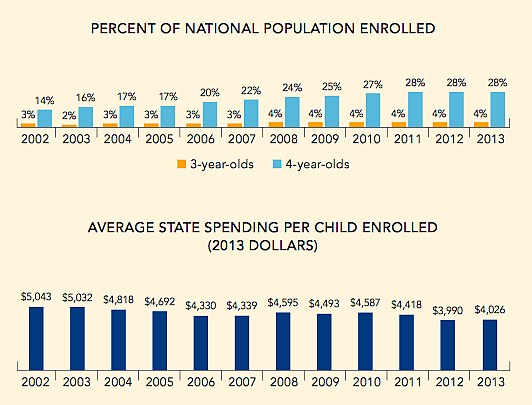Annual report casts sober light on preschool's big push

This week provided a healthy reminder of the difference between perceptions fed by the news cycle and measurable on-the-ground realities.
Just last week I mentioned in passing that efforts to expand pre-K are having a banner year. President Obama has routinely stumped for high-quality pre-K and governors across the country have announced plans to ramp up state programs. Just in time, too: Nobel-laureate economist James Heckman published fresh research last month pointing to major later-in-life health benefits from one justly famous pre-K program.
This all means we’re fast approaching a pre-K golden age, right?
A new report out this week from the National Institute of Early Education Research (NIEER) cleanly punctures that fantasy. Or more precisely, if major changes are indeed afoot, they had yet to surface in time for last year’s data. NIEER’s yearbook finds total enrollment in state-funded pre-K programs was down slightly in 2012-13, while per-child funding flat-lined.
Among 4-year-olds, pre-K enrollment dipped nationwide by about 9,000 kids. That’s a tiny number — and doesn’t change the nationwide figure of 28 percent of 4-year-olds enrolled in state-funded pre-K — but it’s notable because it’s the first time a decrease has been recorded since NIEER began keeping tabs on the enrollments in 2001.
“If we’re going to lead in the global economy, we must do better. In countries like Germany and Japan, more than 95 percent of 4-year-olds are enrolled in early childhood education,” Secretary of Education Arne Duncan said in a May 12 press call on the report’s findings.
While 20 states actually increased pre-K enrollment compared with the 11 states where it sank, the decreases in states such as California (15,000 kids) were large enough to pull the national total into the red.
State funding for pre-K last year fell into the no-news-is-bad-news category. Total funding rose by $36 a child or 1 percent, a figure made even more underwhelming by the fact that the increase “regains less than 10 percent of the prior year’s cut of $442 per child,” according to the report. In 2012, nearly a half-billion was shaved from pre-K budgets nationwide.
(Image: NIEER 2013 Yearbook)
If public pre-K circa 2013 was more or less stuck in terms of funding and enrollment, it won’t surprise anyone that quality measures are running flat, too. NIEER’s Preschool Matters blog summarizes the findings:
Only 15 states could be verified as providing enough per-child funding to meet all 10 benchmarks for quality standards. As only 19 percent of the children enrolled in state-funded pre-K attend those programs, it seems likely that most children served by state pre-K attend programs where funding per child is inadequate to provide a quality education.
That means only about one in five kids is in a top-level pre-K program, at least as defined by NIEER’s preferred benchmarks. That’s disheartening, since in the emerging scientific consensus on pre-K, “high quality” is everything. Many of the benefits ascribed to preschool — heightened social and emotional skills, academic gains, long-term health benefits — depend on skillful, caring instructors, small class sizes and the kind of professional development and pay that can attract and retain teacher talent.
Heckman’s latest research on North Carolina’s famous Abecedarian preschool program found that participants in the treatment group were significantly healthier by their mid-30s. Yet it’s worth pointing out that Abecedarian was an unusually intensive program from birth through 5 that fused education, nutrition and health care at a cost of $67,000 (2002 dollars) a student. Few if any state-funded programs in NIEER’s review could possibly meet this standard – or promise similar health gains.
The biggest states, such as California and Texas, are still struggling to limit class sizes and institute higher teacher standards. Others, such as Arizona, lost ground — lead pre-K teachers there no longer need a bachelor’s degree, according to this year’s report. NIEER’s yearbook finds that “more than half a million children, or 41 percent of nationwide enrollment, were served in programs that met fewer than half of the quality standards benchmarks.”
That suggests we’re still a long-way from widespread adoption of the kind of top-tier pre-K programs known to convey lasting social and health benefits.
The best news from NIEER’s latest report may be that it describes last year. In his press call, Duncan tried to counter the glum 2013 assessment by pointing out that “the tremendous expansion we’ve seen in state-funded preschool programs in the last year is not captured in this report.”
As evidence, Duncan cited 30 state governors who increased pre-K funding last year, as well as mayor-led initiatives in Boston, San Antonio and Seattle. In addition, Congress approved $250 million for preschool development grants earlier this year. (So far, President Obama’s $75 billion Preschool for All proposal remains mired in Congress.)
So will efforts underway this year show up next year as rising enrollments and better quality?
It’s still too soon to tell. For now, the recession’s hangover still lingers in the data.
Read the full NIEER report here, or find your state’s profile here.
Photo by U.S. Army via Flickr.
Related posts
Preschool is important, but years before are crucial
New Study of Classic Early Childhood Program Shows Big Health Gains
When It Comes to Making Preschool Work, Quality is Key
New Report Distills Decades of Preschool Research

